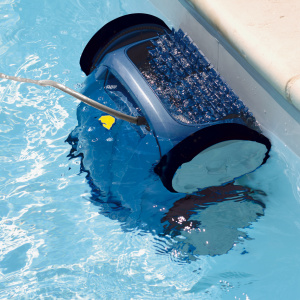Heated water in the pool should be provided in advance, namely at the design stage, since the installation of heating devices is conveniently carried out together with other equipment. However, to embed the heating system will turn out after the construction work. So, what devices exist for heating the basin, what are their advantages and features of use?
Flowing electric heaters
This is the easiest method that will help heat the water in the pool and at the same time not to spend a lot of money on the installation. The purpose of such equipment lies in the heating of the fluid, the flow of which is not interrupted, provided that the pressure drop is minimal. The device is compact, and due to this its installation does not require the presence of a large technical room, the system will well fit into a small covered booth. Water heating is quick, it is possible to regulate its temperature. When buying a flowchart, it is necessary to take into account the volume of water in the pool: for example, for a small and shallow pool in a heated room, a power unit with a power of 3 kW is sufficient. But for a huge outdoor pool, this option is not suitable, because this parameter is limited to 18 kW, which will not be enough. Also, an obvious disadvantage, in addition to low power, it is considered the impossibility of using in homes where limited power consumption is observed.
Heat exchangers
Unlike flowing electric heaters, such devices do not consume electricity, but they warm the pool due to the connection to the heating system of the house. The unit is made in the form of a flask, inside of which a coil is located, where from the heating system comes hot water by operating the circulation pump. The heat exchanger is a fully automatic device, from the owner only you need to install the temperature on the thermostat, which is planned to warm the water. The device has much more power than in the first version - 13-200 kW, which allows it to apply it for large pools. When installing the heat exchanger, one rule should be adhered to: to have a pumping stations and the system responsible for disinfection of water, otherwise damage is possible due to the presence of chlorine in it. In addition, in the case of highly chlorinated water, it is better to choose a titanium heat exchanger.
Heliosystem
The sun is an inexhaustible source of energy, and today this technique has found its use not only when heating the dwellings, but also the construction of the pools. The solar collector is represented by modules (columns, tubes or screens) of black color that take over the sun's rays. After absorption of the rays, heating the coolant inside the collector. And after the launch of the circulation pump, the heating of the pool is carried out. One module heats about 30 cubic meters. meters of water. Along with the heated pool, this method is also suitable for the heating of rooms, and for hot water supply. However, the heliosystem is not devoid of deficiencies: the efficiency of collectors is reduced into cloudy weather, which reduces the heat transfer ratio.
Heat pumps
Such instruments in our country are not widely popular, as their price is still high. The operation of heat pumps consists in a multistage transfer of heat from coolants by compressing gases. The initial sources of heat can be the following: household drains after cleaning, heat of river, lake and groundwater, up to heat released during the purification of flue gases. After performing its purpose, the working fluid and refrigerant are again found to start a new cycle. The power of the system is enough for the heating of the pool, and the cottage heating, which reaches 300 square meters. meters. Water heats up quickly, which is undoubtedly a significant advantage of this technique.
Thus, when choosing a method of heating the pool, it is recommended to take into account its volume, water heating rate, the need for additional home heating, the cost of the system and the power of the device.


































